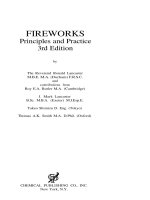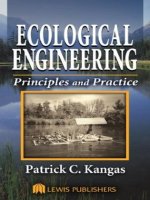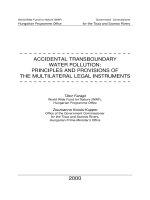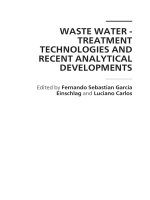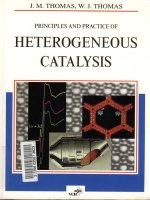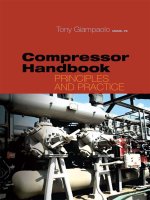boiler water treatment principles and practice vol 1 & 2
Bạn đang xem bản rút gọn của tài liệu. Xem và tải ngay bản đầy đủ của tài liệu tại đây (40.41 MB, 995 trang )
Boiler Water Treatment
Principles and Practice
Volume
I
Boiler Basics and Steam- Water Chemistry
Volume
I1
Treatments, Program Design,
and Management
Colin
Frayne
CHEMICAL PUBLISHING CO. INC.
New
York, N.Y
©2002 by Colin Frayne
Library of Congress Cataloging-in-Publication Data
Frayne, Colin.
Boiler water treatment : principles and practice / Colin Frayne.
p.
cm.
Includes bibliographical references and index.
ISBN 0-8206-0371-6
1.
Feed-water purification. 2. Boilers—Water supply. I. Title.
TJ379.F73 2002
1
2002073523
All rights reserved. No part of this publication may be reproduced, stored in a retrieval system,
or transmitted, in any form or by any means, electronic, mechanical, photocopying, recording,
or otherwise, without the prior permission of the publisher and copyright owner.
Printed in the United States of America
PREFACE
This is my second book. It follows a similar style and with similar objec-
tives and outlook to Cooling Water Treatment: Principles and Practice,
which was published in early 2000. In the preface to that book, I stated
that "the vital key to successfully providing water treatment programs
today is something it has always been—excellent customer service!" In
this particular aspect, some things just do not change, and for the vast
majority of industrial, institutional, and commercial boiler plant owners
around the world, this message is hopefully welcome. I say this because
in order to attain and maintain optimum day-to-day boiler waterside
operating conditions, owners and operators will continue to need the
very best technical advice and other services possible to manage proac-
tively the water treatment programs they employ.
There are some differences, however, between cooling water cus-
tomers and boiler water customers in their overall requirements for water
treatment program management (in Sandler® Sales Institute sales train-
ing "speak," the level of customers' "pain"). And it is these differences
that, in part, gave rise to my decision to write this particular book.
It is a certainty (at least in my mind) that there is no cooling system
anywhere in the world, from the smallest to the very largest, whose
owner or operator cannot benefit from working with an appropriately
qualified water treatment service company to some degree or other. The
complexities of interrelated waterside problems, the variability of
today's water supplies, and the sheer range of modern chemical treat-
ments (now globally available), equipment options, and application
techniques are simply overwhelming. This means that owners and oper-
ators of cooling water systems cannot remain conversant with all the
causes and effects of waterside problems or keep abreast of market-
place technologies and developments in support services.
However, it is not always the case with certain types of modern boil-
er plant that the respective owners, operators, and technical committees
can significantly benefit from working with a water treatment company.
vii
viii
Preface
For example, in some very specialized areas of boiler water treat-
ment (such as nuclear power units and especially utility power genera-
tion),
there is probably little or nothing of any practical value that
service companies can teach the current practitioners.
For a second group, however, comprising the owners and operators
of just about every other type of commonly available boiler plant, this
is not always the case. The engineers responsible for the great majori-
ty of "ordinary" boiler plants found in commercial buildings, hospitals,
hotels, and general industry around the world typically do not have the
same level of resources as the power generation industry.
Consequently, they need to be in a position to reliably obtain specialty
waterside treatment programs and technical support services.
It is these differences in in-house boiler plant facility resources and
the perceived need to obtain technical support from an external source
that led me to consider grouping boiler plant systems in a slightly
dif-
ferent way than is typically perceived, which in turn provided a focus
for this book. Thus, although commercial, industrial, and utility steam
generators can be classified in several different ways (such as by pres-
sure,
output, fundamental design type, etc.), their owners and operators
can be classified as members of one or other of only two groups.
The first group consists almost exclusively of these large utility
organizations that operate electrical power generators and employ high-
pressure, fossil fuel or nuclear power fired boiler plant for steam gen-
eration. This international power generation group understands their
own particular waterside problems very well and the chemicals, mech-
anisms, and protocols needed for proper control. Their field of water
treatment is fairly narrow, but they possess an incredibly deep knowl-
edge of high-pressure boiler waterside technology and consequently
need no assistance from me. (Nevertheless, for the sake of complete-
ness,
and hopefully for the interest of many operators, some informa-
tion on higher pressure boiler water treatment practice has been
included in this book).
The second group consists of every other type of boiler plant owner
or operator. This group includes not only all the engineers operating
steam generators in countless small factories, commercial premises, and
institutional buildings, but also the various larger process industries and
some facilities that may, in fact, generate electricity (albeit at only mod-
erately high pressures) such as the cogeneration/combined cycle plants.
Within this second group, the various types and designs of boiler
operated are very broad and the classifications and applications of boil-
er water treatments are equally wide.
Preface
ix
At first glance, and despite there having been little in the way of
ground-breaking advances in treatment chemicals, equipment, or pro-
gram applications for many a year, the fundamentals of the science and
business of boiler water management appear to be, on the whole, still
imperfectly understood by this group.
It also appears that most commonly available technical books and
other sources of literature tend to concentrate on the higher pressure
"glamour" end of the boiler plant range, and there is little that is suffi-
ciently practical or comprehensive concerning the lower pressure mar-
ket. And, of course, it is this lower pressure market (when measured by
physical number) that globally constitutes the vast majority of boilers
and where the user skills and experience in applied water treatment are
most often limited.
In mitigation, a deep knowledge of such a specialist area generally
is not required for most lower pressure boiler owners and operators, as
they need to focus their attention on primary profit-making activities
and other core business competencies.
It is, thus, to the second group that this book on boiler water treat-
ment is primarily addressed. My key objective was to provide the read-
er with useful and practical boiler plant information that will help
improve waterside cleanliness and add value to their facilities' opera-
tional efficiencies.
Additionally, a personal objective was to provide the information
contained within this book in such a way that it could be used regular-
ly in the field rather than be relegated to a bookshelf with other works
of occasional reference. As such, although this book is essentially con-
cerned with applied chemistry, I found it necessary to devote several of
the initial chapters to a discussion on some basic but practical engi-
neering aspects. Subjects covered include fluid dynamics, thermody-
namics, the various types and designs of boilers to be found, and the
function of all the critical system auxiliaries and components. The sub-
ject of boiler water chemistry is so inextricably bound up with the
mechanical operation of boiler plants and all their various systems and
subsystems that it is impossible to discuss one topic without the other.
As with my first book, which covered cooling water treatment, this
book also started life after rereading the (still largely relevant) books
written by the late James W. McCoy, who was a supervisor of refinery
services at Standard Oil Company of California. This time my primary
source of inspiration was The Chemical Treatment of Boiler Water,
which was first published by Chemical Publishing Company of New
York in 1981.
Preface
In this preface I also wish to highlight the contributions to the sub-
ject from some other publications, such as the more modern book
Procedures of Industrial Water Treatment by J.N. Tanis and the NALCO
Guide to Boiler Water Systems Failure, as well as the massive, but
superb tome, Steam, Its Generation and Uses from Babcock & Wilcox,
which is now in its 40th edition. These are all excellent works.
Other notaries are the Consensus on Operating Practices for
the Control of Feedwater and Boiler Water Chemistry in Modern
Industrial Boilers (1994 edition), published by the American Society of
Mechanical Engineers, and BS 2486:1997 Recommendations for
Treatment of Water for Steam Boilers and Water Heaters from the
British Standards Institution. The 1994 Consensus (with its engineering
background) and the 1997 version of BS 2486 (with its strength in
operational chemistry) complement each other well. I consider that the
tables and propositions contained in these two booklets jointly repre-
sent a true standard for boiler water treatment operational control.
Consequently, I am pleased to be able to reproduce in this book all the
tables from both publications, having received permission from the
respective organizations to do so.
An acknowledgment of the more than 160 technical references that
supported my efforts is provided in the bibliography at the back of this
book.
As before, I give due recognition to my wife, Carol, for her unstint-
ing loyalty and support in this project. Her support was especially
important, as during the course of writing this book we relocated from
Georgia to New York City and most of the problems associated with
moving and then remodeling an old Tudor style house were left to her.
During much of this period I was busy working in an office during the
day, writing at night, and generally insulated from much of the every-
day drama.
I also thank Dr. Bennett P. Boffadi for taking time away from his
consulting work to pore through this book and correct my technical
mistakes.
Finally, I thank Silvia Soto-Galicia and her staff at Chemical
Publishing Co. for their perseverance and confidence in publishing my
work for a second time.
Colin Frayne
New York City, 2002
CONTENTS
Introduction: The Function of Boiler Water
Treatment and Its Marketing xvii
1 Steam Generation 1
1.1 Basics of Steam Generation 4
1.2 Energy, Work, and Power 10
1.3. Boiler Plant Efficiency 14
2 Boiler Types and Applications 23
2.1 Electric Boilers 24
2.2 Fire Tube (Shell) Boilers 29
2.3 Water Tube Boilers 39
2.4 Nuclear Reactor Boilers 61
3 Boiler Plant Subsystems, Appurtenances, and Auxiliaries 67
3.1 Boiler Plant Subsystems 69
3.2 Boiler Appurtenances 72
3.3 Boiler Auxiliaries 82
3.4 Balance of Plant (BOP) Equipment 112
3.5 Boiler Plant Operational and Water Treatment Basics 119
4 Waterside and Steamside Problems: The Basics 131
4.1 Hot Water and Steam System Cycles 132
4.2 The Scope of BW Treatment and Control of
Steam/Waterside Chemistry 134
4.3 Fundamental Steam-Waterside Problems and
Water Treatment Objectives 140
4.4 Deposition 144
4.5 Corrosion 149
4.6 Fouling 153
4.7 Contamination 154
4.8 Limiting the Potential for Waterside Problems 156
xi
xii
Contents
5 Waterside and Steamside Problems: Hot Water
Heating and Low-Pressure Steam Boiler Specifics 173
5.1 Problems with Heating Coils 175
5.2 Problems Associated with the Use of Glycols 177
5.3 Problems of Corrosion in Hot Water and
Low-Pressure Steam Heating Systems 178
5.4 Other Waterside Problems in Hot Water Heating
and Low-Pressure Steam Systems 180
5.5 Waterside Problems in Medium-Temperature
Hot Water and High-Temperature Hot Water Systems 185
6 Waterside and Steamside Problems: Pre-Boiler
Section Specifics 191
6.1 Overview of Pre-Boiler Section Waterside Problems 192
6.2 Feedwater Contamination from Makeup Water 193
6.3 FW Contamination from Returning Condensate 203
6.4 Problems Associated with the Final Feedwater Blend 206
7 Waterside and Steamside Problems:
Boiler Section Specifics 217
7.1 Boiler Scaling, Fouling, and Deposition 217
7.2 Passivation and Common Corrosion Problems 237
7.3 Stress and High Temperature-Related Corrosion 254
7.4 Other Forms of Corrosion 262
7.5 Corrosion in Nuclear Powered Steam Generators 265
8 Waterside and Steamside Problems:
Post-Boiler Section Specifics 273
8.1 Steam Purity and Steam Quality 275
8.2 Corrosive Gases in Steam and Condensate Systems 284
8.3 Vaporous Silica and Other Steam Volatiles 293
8.4 Scale and Corrosion Debris Transport 296
8.5 Oil and Process Contamination 298
9 Pre-Boiler and Post-Boiler Treatment Processes 303
9.1 Overview of Common External Treatment
Process Technologies 306
9.2 Basic Pretreatment Processes 307
9.3 Pre-Boiler Purification Technologies 341
9.4 Post-Boiler Condensate Conditioning 376
9.5 Novel Pretreatment Oxygen Removal Technologies 382
Contents
xiii
10 Internal Treatment Programs 385
10.1 Outline of Internal Treatment Control and Programs 386
10.2 Anodic Inhibitor Chemistries 394
10.3 Tannin Programs 403
10.4 Coagulation and Precipitation Program Chemistries 411
10.5 Chelant Program Chemistries 430
10.6 All-Polymer/All-Organic Programs 437
10.7 Chelant-, Phosphate-, or Polymer-Based,
Combination Programs 461
10.8 Coordinated Phosphate and Program Derivations 464
10.9 All-Volatile Treatment Program Chemistries 474
10.10 Mixed Treatment and Zero Solids Treatment 476
10.11 An Outline of Water Treatment for Nuclear
Powered Steam Generators 477
11 Adjuncts and Conjuctional Treatments 479
11.1 Oxygen Scavenger Chemistries 479
11.2 Oxygenated Treatment (OT) 506
11.3 Ammonia and Amine Adjuncts 510
11.4 Alkalinity Boost Chemistries 545
11.5 Antifoam and Defoamer Chemistries 548
11.6 Multiblend Formulations 555
12 Control of Boiler Water Chemistry 559
12.1 Water Treatment Recommendation Perspectives 560
12.2 Tables and Supporting Notes 566
13 Operational Control of Waterside Surfaces 599
13.1 Sampling and Testing Steam and Condensate 599
13.2 Managing Standby and Idle Boilers 606
13.3 Boiler Inspections 612
13.4 Boiler Cleaning 623
13.5 Some Troubleshooting Notes 657
14 Control of Fireside Conditions and Surfaces 669
14.1 Basic Fireside Problems 670
14.2 Fuel Treatments/Additives 678
14.3 Fuel Treatment Formulations 687
14.4 Combustion Gas Analysis 689
xiv Contents
Appendix I Useful Data 695
Appendix II Glossary 711
Bibliography 763
Index II
INTRODUCTION: THE
FUNCTION OF BOILER
WATER TREATMENT AND
ITS MARKETING
Boilers are heat-transfer devices, wherein water, in the form of either
liquid water or gaseous steam, is commonly employed as a medium for
the transport of heat to some distant point of use. Although other heat-
transfer mediums are sometimes utilized, water is particularly suitable
because of its relative abundance, low cost, and high heat capacity. It is
generally the medium of choice in most boiler applications, whether for
domestic, commercial, institutional, or industrial purposes.
However, a boiler can only carry out its primary functions of trans-
ferring heat to water and (in steam generators) separating steam under
pressure from water most efficiently if the quality of the various types
of water used (such as makeup water, feedwater, and boiler water) are
effectively and continuously controlled. The difficulty in this quality
control process is that water is a "universal solvent," and as a result, all
sources of water contain various natural concentrations of dissolved
minerals and gases in addition to suspended solids and biological mat-
ter. The relative amounts of each of these impurities tend to vary con-
siderably with geographic location and season. This phenomenon
results in countless permutations of water type and quality around the
world, each potentially available as a source of makeup supply to boil-
er plant systems, evaporators, and other forms of water heating and
steam generating devices. In many industrial applications, the negative
impact of these natural impurities may be further compounded by the
presence of small concentrations of process contaminants.
The effect of these various impurities or contaminants is to hinder the
heat-transfer and steam generation processes, to adversely affect the
xvii
xviii
Boiler Water Treatment: Principles and Practice
quality and purity of steam, and to act as primary instigators in the cor-
rosion and wastage of boiler plant system materials of construction. A
wide variety of chemical reactions and physical mechanisms can and will
take place, including the deposition of various crystalline and noncrys-
talline scales on the waterside of heat-transfer surfaces, the formation of
sludges, metal corrosion, and carryover of contaminants into the steam.
The function of boiler water treatment, therefore, is to control the
waterside chemistry of boiler plant systems within certain agreed and
relevant parameters and specifications. As these adverse processes are
by no means limited to the boiler
itself,
in practice, boiler water treat-
ment also includes pre-boiler and post-boiler functions and further
requires that all the various types of water utilized are controlled through
a comprehensive treatment and proactive management program.
Clearly, the lack of or the use of an inappropriate boiler water treat-
ment program creates significant operational difficulties and impacts
the economics of the entire process, from start to finish.
With regard to the marketing of boiler water treatment programs and
services, in the preface to this book I suggested that, although boiler plant
can be classified in several different ways, there are from my perspective,
only two groups of boiler plant owner/operator to be addressed.
1.
The first group consists almost exclusively of the large utility organ-
izations that operate electrical power generation facilities.
2.
The second group consists of all the other types of boiler facilities
and is clearly a very large and extremely diverse group, utilizing
boiler plant ranging from very small steam producers to very large
ones and including many that also produce some electricity togeth-
er with process steam.
From a water treatment technical and marketing viewpoint, there is,
in fact, a fundamental distinction between these two groups, as dis-
cussed below.
Utility power generation group: This group of boiler operators
typically possess boiler plant installations of complex water-tube con-
figuration, often producing steam in excess of 1,500 to 2,000 psig and
increasingly, up to double this pressure. They tolerate only very high-
purity makeup (MU) water, use very little chemical treatments, and
what they do use is generally of a commodity nature.
Internationally, this group has within its ranks an army of experi-
enced chemists and engineers plus a seemingly almost unlimited source
of research and development information. Much of this information is
Introduction: The Function of Boiler Water Treatment xix
tightly held within the international utility power generation communi-
ty and if available in book or other hard-copy form is generally prohib-
itively expensive for outsiders to purchase.
The fundamental reason for the commitment of this group to attaining
the highest purity of feedwater (FW) and the most exactingly controlled
internal boiler waterside conditions is the nature of the primary product
made available for sale. This group generates electricity, on which all
developed and developing nations critically depend for their economic
and social well-being. The production of steam is merely an intermedi-
ate,
but the quality and quantities of steam produced has a direct bearing
on total electricity output, generation efficiency, operational and mainte-
nance costs, and ultimately the price paid by the consumer.
Heating, process steam, and cogeneration group: As a contrast to
the utility power generation group, operators of all the other types of
boiler plant typically have installations producing steam (or hot water)
at very much lower pressures. In fact, most facilities operate boilers
somewhere within the range of only 5 to 125 psig, although larger
process plants and cogenerators may reach pressures of up to 1,500 psig.
Because of the diversity of this group, there is no global standardi-
zation with regard to makeup (MU) water, FW quality, or boiler water
(BW) chemistry control, irrespective of boiler design, pressure rating,
or ultimate steam purpose. True, there are various national standards
and boiler manufacturer association recommendations, and while these
guides are extremely useful, they seldom universally agree on any
given parameter or protocol. In mitigation, they cannot hope to provide
answers to the myriad of problems and specific circumstances that
develop. Rather, they should be viewed as a starting point for control
purposes.
What is clear is that it is seldom that MU water or FW quality (i.e.,
the lack of contaminants) used by this second group ever reaches the
incredible standards demanded and produced by the first group. Indeed,
it is not at all uncommon to find lower-pressure boiler installations with
MU water and FW both inadequately treated and simply inappropriate
to the facilities needs.
Low standards of water treatment and waterside chemistry are gen-
erally caused by a combination of bad advice and lack of operator moti-
vation or resources, and provide an initiator for the onset of
downstream waterside operational problems. However, despite these
apparent water treatment imperfections, most operators somehow still
manage to function and produce steam of an acceptable quality and
quantity, year after year!
XX
Boiler Water Treatment: Principles and Practice
This second group also, in fact, contains many electricity producers,
the so-called cogenerators or combined-cycle plant operators. While
there is no apparent clear-cut distinction between these facilities and the
large utilities, in practice, the cogenerators tend not to operate at such
high pressures (although the generation of power economically usually
requires at least 650 psig). Also, although the demands for good quality
FW treatment and steam purity in this group is high, it tends not to reach
such extremes of sophistication as demanded by the utility group.
It can be seen that the first group demands the highest possible qual-
ity of steam purity and steam generation operating control and water-
side chemistry is "knife-edge" technology. Consequently, from a water
treatment products and services marketing viewpoint, this group offers
the minimum of opportunities as a potential source of revenue. Even
where an opportunity exists, perhaps for the supply of a special poly-
meric dispersant or an esoteric oxygen scavenger, the service company
may often discover that because of the bureaucratic and accreditation
systems to be worked through, the gain may not be worth the effort.
Looking further at the second group, although many of the larger,
non-utility operators around the world retain a resident water services
chemist or trained technician, there is a marked tendency for all own-
ers or operators, whether large or small, to work in conjunction with a
water treatment service company. There is also a common purpose to
use branded BW treatment chemical products rather than commodities.
Thus,
a good source of potential revenue for products and services
exists in the multitude of smaller boiler-houses to be found operating
around the globe. It is here that practical advice is most often needed
concerning the suitability and correct application of chemical treat-
ments, the regular interpretation of analytical results obtained, and the
strategies to be employed to maximize efficiency and reduce costs.
Marketing to this second group is typically based on selling some
form of services-based annual contract, using the customers boiler
plant operating capacity or potential for steam production as a guide for
determining base requirements and for pricing purposes.
Hot water heating and LP steam systems are relatively easy to treat,
given:
• Customer acceptance of the need for treatment (which is not always
forthcoming).
• An appropriate water treatment program (which is not always pro-
vided, often due to cost issues).
Introduction: The Function of Boiler Water Treatment xxi
• Some customer/vendor cooperation (which, thankfully, is usually
the case).
In contrast, the treatment of industrial steam generation plants is
usually more difficult. There is a need to conform to a good working
standard and to produce quality waterside conditions for a long period
of time without serious upsets, as the systems are always very dynam-
ic and operating conditions can continually vary. This is especially the
case with those facilities whose manufacturing operations may employ
some form of on-off cycle or up-down batching process, rather than a
steady-state, continuous production stream.
With the smallest heating boilers or low volume/low pressure steam
producers, water treatment service companies tend to promote easy-to-
understand programs, typically based on only one or two multiple-
component, blended chemical products (multiblends or one-drum
treatments), or increasingly, the novel crystalline solid concentrates
(solid water treatment). These customers often have only very limited,
water-related, in-house technical skills, and multiblend product pro-
grams will seem attractive because they are relatively easy to apply.
However, the blending process makes it notoriously difficult to control
individual component reserves in the boiler and generally adds consid-
erably to the overall program costs.
Thus,
programs based on multiblends are relatively expensive to use
compared with programs based on the use of separate products that are
matched to the potential for particular problems identified in a boiler
plant. Nevertheless, they remain commonplace for the smallest boiler
houses, but as the organizational size of the customer and its volume of
daily steam production increases, so the trend for individual chemical
treatments on the site tends to predominate. Often, more sophisticated
chemical feed and control arrangements are also employed.
Traditionally, customers employ water treatment service companies
simply as external contractors to assist in the maintenance of clean and
efficient waterside surfaces in their various heating, steam generating,
cooling, and certain industrial process systems. The customers benefit
from genuine improvements in operating efficiency, reductions in main-
tenance time, and replacement component costs. In addition, where
industrial processes are involved they often profit from an "added-value,"
due to an improved product quality or reduction in manufacturing cost.
In this external contractor role, water treatment companies providing
technical application and problem solving services are required to pos-
sess some general design component and process operating knowledge
xxii
Boiler Water Treatment: Principles and Practice
of all the very many different types of industrial water systems to be
found. In addition, they must possess specific and relevant water treat-
ment technical knowledge, together with the practical experience of
anticipating and solving water-related problems. Thus, the service
companies that can best utilize their "storehouses" of knowledge and
provide the necessary customer technical support and practical field
skills also tend to gain a good reputation. Ultimately, they generate
profit from their solid asset-base of people and knowledge.
It is a fact of life that the cost of providing water treatment services
increases with the size and complexity of boiler plant. This cost may be
recovered with larger boiler plants by the higher volumes of chemical
treatments sold, as often the chemical selling prices will include an
allowance for all the anticipated (and expensive) technical service time
requirements.
For smaller chemical volume consumers, especially those with little
in the way of in-house BW treatment technical skills, the overall pro-
gram costs can be relatively high. This typically is due to the dispropor-
tionately high requirement for on-site technical service time (including
the travel time to and from a customer's site) compared to the volumes
of chemical treatment sold. Travel and on-site time is expensive.
Typically, the cost of labor and technical service is two to three times the
cost of the chemical raw materials used to provide treatments.
As a result of the high costs of technical services, most water treat-
ment vendors employ a variety of methods that allows them to charge
an economic rate for the programs they sell. They will negotiate a
price with the customer based on providing the most suitable balance
of on-site service time and chemical/equipment requirements, that
anticipates and resolves problems, meets the customers needs, and
relieves his or her "pain."
Traditionally, a common solution to the problem of matching rela-
tively higher levels of technical support with lower chemical volumes
for these smaller customers has been via a one- to three-year, fully inclu-
sive product and services contract. Such a contract will specify the fre-
quency of service visits to be made to the customer's site and the type
of work to be carried out. It will also, perhaps, limit the maximum vol-
umes of chemical treatments to be supplied during the contract lifetime,
or perhaps designate the amount of chemicals required based on treat-
ing a certain annual volume of boiler FW. Contracts may include for the
provision of chemical feed and control equipment and for the supply of
labor for boiler cleaning, chemical addition, and drum removal services
(drumless delivery). Product and services contract prices may some-
Introduction: The Function of Boiler Water Treatment xxiii
times be specified as a cost-per-unit of steam produced (i.e., so many
cents per 1,000 lb. of steam) or a cost-per-unit of production.
Under these conditions, the customer will receive a demonstrable
benefit and, provided the on-site time and the volume of chemicals
shipped are adequately controlled, the Service Company will derive a
satisfactory profit.
Nevertheless, and irrespective of the particular mechanisms of pay-
ment for program services rendered, profit and a win-win situation will
only arise for both parties if the work performed is managed compe-
tently and in a spirit of mutual cooperation.
Thus,
if a field representative believes that the task is completed
when the testing of water samples is performed and a service report is
issued, or if the representative's interpretation of results is poor, prob-
lems will undoubtedly develop. Also, if he or she fails to adequately
review the "bigger picture" rather than merely individual results, the
problems will magnify and the contract will ultimately be lost.
Similarly, if the customer refuses to be involved, at least to some
degree, in the ongoing water treatment program or fails to take the
advice and undertake necessary actions designed to control the pro-
gram and the boiler system efficiency, the program will again ultimate-
ly fail and the contract will be lost.
Today, the traditional view of boiler water treatment (and water
treatment in general) is changing. The marketplace is indicating that
water treatment is merely part of a more comprehensive technical sup-
port and management services industry for various water, wastewater,
and manufacturing process systems. Increasingly, water treatment is
widening in scope to support global market demands. It is becoming an
outsourcing services business for managing all forms of water, energy,
utility, and environmental needs.
Even without the current outsourcing trends, it has always been
dif-
ficult for service companies to find sufficient numbers of well-trained,
experienced, and motivated field representatives. This is because the
range of water treatment problems and potential solutions are very
wide and the business involves the marketing of many different types
of chemicals and equipment, coupled with consulting work and inno-
vative trouble shooting.
In the water treatment industry, the first line of service providers has
always been the vendor's technical sales representatives, who, for the
most part, are chemists, engineers, microbiologists, or similarly trained
people. The field representatives typically rely on a combination of their
primary disciplines and a depth of water treatment problem-solving
xxiv
Boiler Water Treatment: Principles and Practice
experience to overcome technical and operational problems and also add
value to their customers operations. But in today's global economy, the
sheer permutation of available niche services, the growing demands for
both outsourcing of non-core utility functions, and economic fine-tun-
ing, requires that water treaters now commonly have to additionally act
as managers and administrators of their customers entire water system
facilities.
Today, water treatment companies sell environmental reassurance
and technology-based utility support services, not chemicals or equip-
ment.
Boiler water treatment is now an energy management function. And
while the business and practice of this industry may be well over 100
years old, it remains a vitally important function and is a cornerstone of
the global industrial services market.
SYMBOLS AND
ABBREVIATIONS
A angstrom unit
AA/AMPS acrylic acid/2-acrylamido-2-methyl propane
sulfonic acid copolymer
AA/COPS acrylic acid/sodium 3-allyloxy-2-hydroxy-
propane sulfonate (polymer)
AA/NI-AS-LS acrylic acid/nonionic aromatic and linear
sulfonate (polymer)
AA/SA acrylic acid/sulfonic acid
AA/SA/NI acrylic acid/sulfonic acid/ nonionic (polymer)
AA/SA/SSS acrylic acid/sulfonic acid/sodium styrene
sulfonate acrylic acid/sulfonic acid/substituted
acrylamide (polymer)
ABMA American Boiler Manufacturers Association
ACH aluminum chlorhydrate
AGR advanced gas-cooled reactor
AMP aminotri-(methylenephosphonic acid)
AMP 2-amino-2-methyl-l-propanol, AKA
isobutanolamine
AO All-Organic
AP 5-aminopentanol
AP/AO All-Polymer/All-Organic
ASB Shell Boiler Makers Association (UK)
ASME American Society of Mechanical Engineers
ASTM American Society for Testing and Materials
1-AP 1-aminopyrrolidine
ATMP aminotri-(methylenephosphonic acid)
AVAT All-Volatile alkaline treatment
AVP All-Volatile programs
XXV
xxvi
Boiler Water Treatment: Principles and Practice
AVT All-Volatile treatment
Barg
bar (pressure), gravity
BD blowdown
BDHR blowdown and heat recovery system
BF
blast furnace
BOF basic oxygen furnace boiler
BOOM build, own, operate, maintain
BOP balance of plant
BS&W basic sediment and water
BSI British Standards Institution
BTA
benzotriazole
Btu/lb British thermal unit(s) per pound
BW boiler water
BWR boiling water reactor
BX base-exchange water softener
CA
cellulose acetate
CANDUR
Canadian deuterium reactor
CDI continuous deionization
CFH
critical heat flux
CFR
Code of Federal Regulations
CHA cyclohexylamine
CHF
critical heat-flux
CHZ
carbohydrazide
CI cast iron boiler
CIP clean-in-place
CMC carboxymethylcellulose
CMC (sodium) carboxy-methylcellulose
CMC critical miscelle concentration
COC
cycle of concentration
cogen cogeneration boiler
CR condensate return
CTTD
condenser temperature terminal difference
CW cooling water
Symbols and Abbreviations
xxvii
d distance
DA deaerator
DA dealkalization
DADMAC polydiallyl-dimethylammonium chloride
DAE
1,2-diaminoethane
DBNPA 2,2,-dibromo-3-nitriloproprionamide
DC direct current
DCA deposit control agent
DCHA dicyclohexylamine
DEA diethanolamine
DEAE diethylaminoethanol, AKA diethylethanolamine
Dealk dealkalization
DEEA diethylethanolamine, AKA diethylaminoethanol
DEG diethanolglycine
DEHA diethylhydroxylamine
DEHA N,N-diethylhydroxylamine
DEHA diethylhydroxylamine
DETPMP diethylenetriaminepenta (methylene phosphonic
acid)
DT differential temperature
DHA dihydroxyacetone
DI deionization
DMAE 2-dimethylaminoethanol, AKA N-N-
dimethylethanolamine
DMAEP dimethylaminoethylpropanol
DMAP dimethylamino-2-propanol
DMEA , AKA 2-dimethy-
laminoethanol
DMIPA dimethylisopropanolamine
DNB departure from nucleate boiling
DO dissolved oxygen
DOT Department of Transportation
DR distribution ratio
DSP (anhydrous) disodium hydrogen phosphate
xxviii
Boiler Water Treatment: Principles and Practice
DTPA diethylenetriaminepentacetic acid
DVB divinylbenzene
DVGW Deutsche Vereinigung des Gas-und
Wasserfaches e.V
EC erosion-corrosion
ED electrodialysis
EDG ethanoldiglycine
EDI electrodeionization
EDR equivalent square feet of steam radiation surface
EDR electrodialysis reversal
EDTA ethylenediaminetetraacetic acid
EMF electromagnetic filtration
EMS electromagnetic separation
EPIDMA epichlorohydrin-dimethylamine
ESA ethoxylated soya amine
ETA ethanolamine
/ force
FB firebox boiler
FBC fluidized bed combustion boiler
FBR fast breeder reactor
FCC fluid catalytic cracking
FD forced draft
FFCPP full-flow condensate polishing plant
FGD flue gas discharge
FSHR flash steam and heat recovery
FT fire tube boiler
FTA Federal Technology Alert
FW feedwater
GAC granular activated carbon
g
c
proportionality constant
GCV gross calorific value
gph gallon per hour
GRAS generally regarded as safe
Symbols and Abbreviations
xxix
GRP
GTM
HAD
HAN
HE
HEDP
HEDTA
HEIDA
HLB
HMDTMP
hp
HP
hph
HQ
HQC
HR
HRT
HV
HVAC
HW
HWR
Hyfor
I&I
IBA
ID
IDA
IP
IPA
IX
a
kcal/min
glass reinforced plastic
gas transfer membrane
hexadecylamine
heavy aromatic naphtha, AKA solvent naphtha
hydrogen embrittlement
1 -hydroxyethylidene-1,1 -diphosphonic acid
N-hydroxyethylenediaminetriacetic acid
hydroxyethyliminodiacetic acid
hydrophile-lipophile balance
hexamethylenediaminetetra (methylene
phosphonic acid)
horsepower (boiler)
high pressure
horsepower per hour
hydroquinone
3-hydroquinuclidine
heat recovery
horizontal return tubular boiler
high voltage
heating, ventilation, air conditioning
hot water
heavy water reactor
hydroxyacetic acid (glycollic acid)/formic acid
industrial and institutional
isobutanolamine, AKA 2-Amino-2-methyl,
1-propanol
induced draft
iminodiacetic acid
intermediate pressure
isopropyl alcohol
ion exchange
acidity dissociation constant
basicity dissociation constant
kilocalorie per minute
xxx Boiler Water Treatment: Principles and Practice
kg kilogram
kPa kiloPascal
kW kiloWatt
kW/hr kiloWatt per hour
lb pound
LP low pressure
LPHW low pressure hot water
LSI Langelier saturation index
LTHW low temperature hot water
LV low voltage
LWR light water reactor
m mass
m meter
mega
3-MPA 3-methoxy-N-propylamine
MAWP maximum allowable working pressure
MB mixed bed ion exchange
MBT (sodium) mercaptobenzothiazole
MCR maximum continuous rating
MEA monoethanolamine
MEKO methylethylketoxime
MIC microbiologically induced corrosion
microSeimen per centimeter
mm millimeter
MM multimedia filtration
MN mega Newton
3-methoxy,n-propylamine
MPHW medium pressure hot water
MSP anhydrous sodium dihydrogen phosphate
MT mixed treatment
MTHW medium temperature hot water
MU makeup water
NaMBT sodium mercaptobenzothiazole

